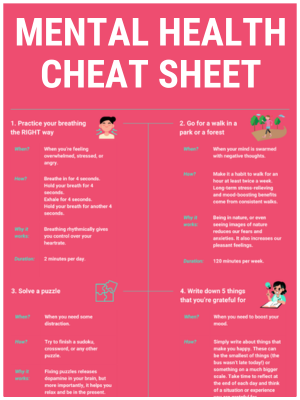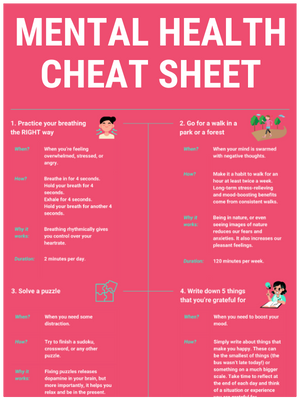Have you ever edited a photo and zoomed in on just a portion of the photo? It changes the entire photo and highlights what you want people to see. You can edit your life in the same way by reframing your thoughts.
Reframing your thoughts can change your entire attitude about your life. When you actively choose to see the good around you, you attract people and experiences that bring more good things your way. And with a little practice, even rough patches can start to look a little brighter.
This article will do a deep dive into how you can start reframing your thoughts to highlight the good and get excited about your life again.
Contents
Why it’s important to reframe your thoughts
Most of us wake up each day and we’re instantly focused on our problems. While this mindset may create a sense of urgency and make us productive, this can more often trigger a thought pattern that has us focusing on the negative.
I know that this used to be me before I took active steps to fight it. I used to wake up dreading work, my to-do list, and feeling anxious about the day ahead.
But then I learned that I was creating my own misery starting with my thoughts. And just like physical training, it takes mental training and practice to take back control of your thoughts.
If you think all this talk of changing your perspective won’t really do anything, think again. Research shows that people who actively focus on the good have a better immune response than those who focus on their stressors.
Both your mental and physical well-being are being controlled by what you allow to happen between your two ears.
How reframing your thoughts affects your mental health
When it comes to your mental health, it seems obvious that reframing your thoughts may make you feel better. But what does the research actually say about reframing your thoughts?
A study in 2016 found that individuals with a generalized anxiety disorder reported a significant reduction in worry and anxiety just by focusing on creating more positive thoughts.
Research also shows that individuals who actively focus on the positive are better at dampening their stress response when bad things happen. In other words, they seem to be more calm and resilient in the face of stress.
I don’t know about you, but when I think about the primary issues in relation to my mental health they all center around stress, anxiety, and worry. And it seems that the solution to these problems might just lie in my thought process around my life and its problems.
💡 By the way: Do you find it hard to be happy and in control of your life? It may not be your fault. To help you feel better, we’ve condensed the information of 100’s of articles into a 10-step mental health cheat sheet to help you be more in control. 👇
8 ways to reframe your perspective
If you’re ready to zoom in on all the good life has to offer and reframe your thoughts, then these eight tips were made for you.
1. Become aware of your repeated thoughts
In order to reframe your thoughts, you first have to become aware of the thoughts you’re having on a consistent basis. Sometimes we don’t even realize we’re stuck in a perpetual negative thought loop.
About a year ago, I was going through a rough patch. I knew I didn’t feel happy, but I didn’t realize just how negative my thoughts were until my husband told me I was being a negative Nancy.
I started to realize that my first thought when I woke up was, “Let’s just get through this day. I can’t wait until it’s over.”
That’s not exactly motivational material to get you to hop out of bed in the morning. And I was saying it to myself every morning.
Become aware of your habitual thoughts and observe them objectively. Once you have this awareness, you can start to actively reprogram your brain with new thoughts.
2. Find a replacement phrase
Once you know your personal thought pattern that you get stuck in, you need to find a phrase or question to get yourself unstuck from that pattern.
Remember my morning statement about not looking forward to the day? After I noticed that this was what I was doing when I first woke up, I decided to come up with a replacement phrase.
Instead, I started saying, “This day is going to be full of happy surprises.” And I had to not only say it but also start believing it.
It may sound silly to you, but that one simple switch cued my brain to focus on the possibilities ahead instead of responsibilities. And I attribute that simple phrase to helping me overcome my depressive attitude.
You can come up with a phrase that works for you, but you need to make it meaningful to you. Because that’s the only way it will stick.
3. Meditation
You had to see this one coming. But before you scroll to the next tip and say you’re not a meditator, hear me out.
I, too, used to say that I wasn’t capable of meditation. My brain would zing around like a dog with the zoomies.
But this was exactly why I needed the meditation. Learning to calm my mind and think about nothing helped me realize just how many negative thoughts I was having on a regular basis.
Meditation is a form of self-awareness. And when you start to meditate, you become in tune with the messages your brain is spewing to you regularly.
Start out small. Try just two minutes. And build it up as you can.
I promise that after you meditate, the way you view the world and your life will change. It takes practice, but learning to think about nothing for a while has helped me reframe how I think about everything.
If you need tips on how to start, here’s our article on meditation that will help you get started!
4. Choose gratitude right when you wake up
This is a biggie. You’re probably starting to pick up on the fact that I’m an advocate for being mindful of what you tell your brain first thing in the morning.
Your brain and your subconscious are particularly sensitive to what you tell it in the morning. So make sure that the message is a positive one.
A good way to reframe your thoughts in the morning to help you reframe your day is to reflect on what you can be thankful for. Looking at what there is to be grateful for helps shift your mindset from one that focuses on what you lack to one that manifests abundance.
It takes two seconds, but list a few things you’re grateful for. And if you want to go all out, do it intermittently throughout the day.
Focusing on gratitude will inevitably change your thoughts.
5. Ask yourself “What could be good about this?”
When it comes to problems, it can be particularly challenging to reframe your thoughts. If you’re like me, it’s natural to want to have a pity party and complain.
And while you can sulk for a brief moment if you need to, it’s important that you don’t stay there long. Because often hidden in the middle of a problem is an opportunity.
When you have a problem, ask yourself the question “What could be good about this?”. That one question has the power to completely shift the way you’re thinking about something.
I remember when my boyfriend broke up with me in grad school I was devastated. I thought my life would never go on without him.
After a few days of going through way too many tissues, I asked myself that question. And then I started to realize that breaking up gave me more free time to pursue my hobbies and time to spend with my friends.
I was able to pursue my passion for climbing more intensely and ended up meeting dear friends because of that breakup.
Ask yourself that question the next time you have a problem. You might be surprised to find out that the answer reveals you didn’t have as much of a problem as you thought all along.
6. Get an outsider’s perspective
If you can’t bring yourself to reframe your thoughts, get an outsider’s perspective. Ideally, this is someone who can be at least slightly objective regarding your situation or circumstances.
I remember when I was trying to make a decision about a former job while being an undergrad. I felt like I wasn’t being given the promotions I deserved at the time and was frustrated.
I asked one of my co-workers for their opinion because I was getting grumpy about the situation.
My coworker told me kindly that I was already at one of the highest on-campus jobs. Not only that, they told me that this job gave me incredible flexibility with my schedule. They even allowed us to take days off when my schoolwork was more important.
Their perspective helped me realize how ungrateful I was about the entire situation. And it helped me remember all the things about my job I loved.
Sometimes another person’s view can help you reframe your view to remind you of what you were missing.
If you find this hard, here’s our article with tips on how to change your perspective.
7. Practice self-compassion
When you are caught in a cycle of negative self-talk or criticism, pause and treat yourself with the same kindness and understanding you would offer a good friend. Acknowledge that everyone has flaws and makes mistakes; this is a part of being human.
Start by identifying the critical voice inside your head and challenge its validity. Ask yourself if you would speak to someone else the way you are speaking to yourself. Most likely, the answer is no.
Replace these harsh thoughts with more compassionate and realistic ones. For example, instead of thinking, “I’m such a failure for not getting this right,” you might reframe it to, “I’m learning and growing, and it’s okay to make mistakes.”
8. Create a positive environment
The environment around you can significantly influence your thoughts and mood. To help reframe your perspective, make an effort to create a positive and uplifting environment. This can include surrounding yourself with positive people who encourage and support you, as well as creating a physical space that inspires positivity.
Start by evaluating your relationships and consider spending more time with those who uplift you and less time with those who bring you down.
Additionally, personalize your living and working spaces with items that bring you joy, such as photos of happy memories, inspirational quotes, or plants. Music can also be a powerful mood enhancer; consider creating a playlist of songs that make you feel happy and optimistic.
By intentionally shaping your environment, you encourage a more positive mindset, making it easier to reframe negative thoughts into positive ones.
💡 By the way: If you want to start feeling better and more productive, I’ve condensed the information of 100’s of our articles into a 10-step mental health cheat sheet here. 👇
This Cheat Sheet Will Help You Be Happier and More Productive
Thrive under stress and crush your goals with these 10 unique tips for your mental health.
Wrapping up
We all get to be the editor of our lives. And with this incredible power comes the ability to reframe our thoughts to help us create a beautiful final image. The tips in this article will help you shift your thoughts to serve you positively. Because at the end of the day, you might just be a thought or two away from a happier life.
What do you think? What’s your favorite tip to reframe your thoughts into something positive? I’d love to hear from you in the comments below!



